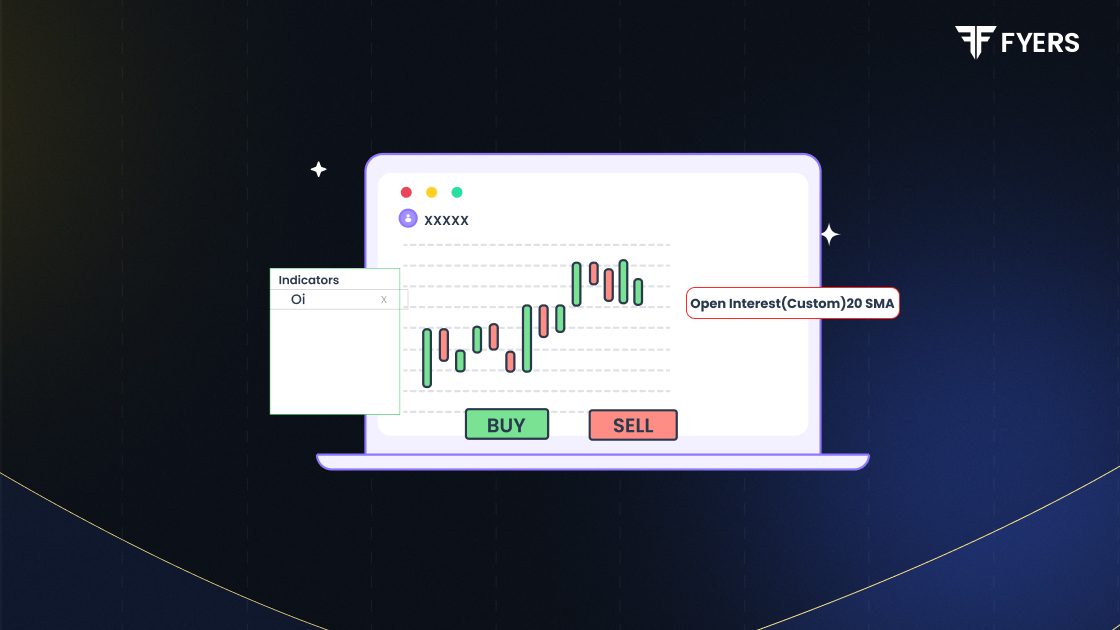

 14 Aug, 2024
14 Aug, 2024
 4 mins read
4 mins read

For most stock traders, tracking price movements and trading volume helps gauge market sentiment and overall trends. However, an additional crucial factor, open interest, also matters for derivative traders. This metric offers insights into the prevailing interest and demand-supply dynamics of derivative contracts such as futures and options. Are you curious to know more? Read on to learn about open interest and what it indicates.
Open interest is an important indicator of market sentiment and refers to the total number of open contracts at a given time. This metric represents the total number of outstanding positions that haven't been closed, expired or settled, helping traders understand the overall market activity, liquidity, and popularity of specific contracts.
An increase in open interest can signify that new money is entering the market, indicating strong participation and the likelihood of a continuing trend. On the other hand, a decrease in open interest could signal traders closing their positions, suggesting a potential market reversal or consolidation.
Open interest allows traders to gain market insights into derivative trading and shape their portfolios. Here are some ways in which open interest can help traders.
Changes in open interest can be a signal for future market trends. An increase suggests a strong trend with more traders participating, while a decrease could indicate a potential reversal as traders exit positions. This information helps in predicting market movements.
Open interest represents the total active options/future contracts in the market, providing insights into market participation and liquidity. High open interest indicates a vibrant market, facilitating smoother and more efficient trades.
Open interest validates price movements. A price increase coupled with rising open interest signifies strong trader support, making the trend more reliable. Conversely, price movements without open interest change may lack stability.
Open interest can reflect market sentiment. Rising interest suggests confidence in the current trend, with call option interest indicating optimism and put option interest suggesting pessimism.
High open interest indicates a liquid market, allowing for quick trades at consistent prices. This liquidity is crucial for traders seeking to execute trades swiftly and efficiently.
Monitoring open interest can aid in risk management by identifying potential volatility. This enables adjustments to trading strategies for better resilience and adaptability.
Changes in open interest near contract expirations can shed light on strategies and market expectations, helping traders navigate expiries more effectively.
The calculation of open interest is straightforward to understand. The formula to calculate open interest is -
Open Interest = Total number of outstanding contracts – Contracts that have been closed
Or
Open Interest = Total Number of Open Long Positions + Total Number of Open Short Positions
These are the two methods to calculate open interest for F&O contracts. The former method gives an idea of the net number of active contracts by considering all the contracts still active after accounting for new and closed contracts.
On the other hand, using the number of open long and short positions to calculate open interest gives a straightforward view of market participation.
Let us consider the following example of open interest to understand the concept in further detail.
Number of options contracts at the start of the trading day = 500 open contracts
Number of new contracts opened during the trading day = 150 new contracts
Number of options contracts closed during the trading day = 100 closed contracts
The calculation of open interest in the above case is explained here using the open interest formula,
Open Interest = 500+150-100 = 550
This helps traders understand the net number of active contracts in the market at the close of a trading session.
Open interest and trading volume are two important terms often used in derivative trading. Here are the meanings and key differences between the two.
|
Subheading |
Open Interest |
Trading Volume |
|---|---|---|
|
Definition |
Open interest represents the total number of outstanding options or futures contracts that are still active and have not been settled. |
Trading volume refers to the total number of contracts that have been traded during a specific period, usually a trading day. |
|
Implication |
It indicates the ongoing interest in a contract. |
It indicates the current trading activity. |
|
Measurement |
The value of open interest increases with new contracts and decreases with settlement. |
The trading volume is counted every time a contract is traded. |
|
Significance |
Open interest reflects the market sentiment and liquidity. |
Trading volume, on the other hand, indicates market momentum and activity. |
|
Usage |
Open interest is used to gauge market interest and potential trend strength. |
Trading Volume is used to identify daily trading volume and momentum. |
Open interest is an important market indicator for futures and options traders. It indicates the total number of outstanding contracts that are still active. It reflects the overall market sentiment and market strength or stability. This helps traders take suitable trading positions and potentially profitable trading portfolios.
Calculate your Net P&L after deducting all the charges like Tax, Brokerage, etc.
Find your required margin.
Calculate the average price you paid for a stock and determine your total cost.
Estimate your investment growth. Calculate potential returns on one-time investments.
Forecast your investment returns. Understand potential growth with regular contributions.